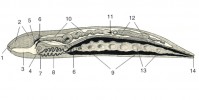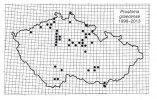Pásemnička sladkovodní (Prostoma graecence) je málo známý, ale běžný vodní živočich. Žije na kamenech a vodních rostlinách v tekoucích i stojatých vodách, především v nižších polohách. Živí se drobnými planktonními a bentickými organismy. Na hlavě má 6 očních skvrn (mladší jedinci 4). Loví pomocí chobotku (proboscis), který obsahuje centrální trn s jedovou žlázou a po stranách 2 – 5 přídatných trnů. Tento orgán je typický pro pásnice (Nemertea).
Použitá a citovaná literatura:
BARTSCH I., 1990: Nemertini. Süsswasserfauna vot Mitteleuropa 3/1+2. Gustav Fischer Verlag. 255–262.
FRANKENBERG VON G., 1936: Die Süsswassernemertine. Mikrokosmos 30: Hft. 1, 175–179.
GIBSON R., 1995: Nemertean genera and species of the world: an annotated checklist of original names and describtion citations, synonyms, current taxonomic status, habitats and recorded zoogeografic distribution. Journal of Natural History. Taylor & Francis Ltd. 29: 271–562.
GIBSON R. & MOORE, 1976: Freshwater Nemerteans. Zool. J. Linn. Soc., 58: 177–218.
KOLASA J., 1973: Turbellaria and Nemertini of greenhouses in Poznan. Acta Hydrobiologia. Krakow. 15: 227–245.
MRÁZEK A., 1900: Ueber das Vorkommen einer frei Lebenden Süsswassernemertine (Stichostema graecense Böhm.) in Böhmen. Separatabdruck aus den Sitzungsberichten der königl. Böhm. Gesellschaft der Wissenchaften in Prag. 1–7.
MRÁZEK A., 1902: Ein Beitrag zur Kenntniss der Fauna der Warmhäuser. Sitzungsberichten der königl. Böhm. Gesellschaft der Wissenchaften in Prag. XXXVII., II. Classe: 1–21.
MRÁZEK A., 1902: Frei Lebenden Süsswassernemertine in Böhmen Süsswassernemertine. Separatabdruck aus den Sitzungsberichten der königl. Böhm. Gesellschaft der Wissenchaften in Prag. 1–7.
REISINGER E., 1938: Nemertini. Schurwürmer. In: SCHULZE P., 1938: Biologie der Tiere Deutschlands. Erstes Band: Protozoa, Spongiaria, Cnidaria, Vermes I (bis Gastrotricha). Berlin. 7: 1–24.
RIMSKI-KORSAKOV M., 1910: Zur Biologie der Süsswassernemertine Stichostema graecense Böhmig. Sonderadbuck aus dem „Biologischen Centralblatt“. Bd. XXX. Nr. 17. Leipzig. 1–9.
SEKERA E., 1912: Beiträge zur Lebensweise der Süsswassernemertinen. Separatabdruck aus den Sitzungsberichten der königl. Böhm. Gesellschaft der Wissenchaften in Prag. 1–29.
SEKERA E., 1913: O ústrojnosti sladkovodních nemertinů. Příroda 11: 1–17.
SEKERA E., 1938: O nové lokalitě sladkovodních nemertinů. Věda přírodní 19: p. 20.
ŽÁKOVÁ Z., OPRAVILOVÁ V., SCHENKOVÁ J., MLEJNKOVÁ H., 2004: Occurence of freshwater sponges (Porifera, Spongillidae) and sponge-associated organisms in the Dalešice and Mohelno Reservoirs (Czech Republic). In Sripta. Brno : Masaryk University, 2004. Biologia, ISBN 80-210-3554-4, s. 9–41.
The ribbon worm Prostoma graecense (Nemertea) is a little known but common water animal. It occurs on stones and plants in running and standing waters, mostly in the lowlands. It is a carnivore feeding on tiny planktonic and benthic animals. P. graecense has 6 black eyespots (young specimens have four) on the top of its head. The eversible proboscis is armed with one central stylet with a poison gland and paired pouches each containing two to five accessory stylets. The proboscis is a typical apparatus of ribbon worms, used for hunting.
 Aktivní pásemnička sladkovodní (Prostoma graecense) v laboratorním chovu. Foto J. Špaček
Aktivní pásemnička sladkovodní (Prostoma graecense) v laboratorním chovu. Foto J. Špaček









